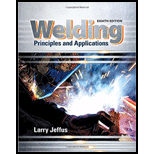
Bundle: Welding: Principles and Applications, 8th + MindTap Welding, 4 terms (24 months) Printed Access Card
8th Edition
ISBN: 9781337219426
Author: Larry Jeffus
Publisher: Cengage Learning
expand_more
expand_more
format_list_bulleted
Concept explainers
Textbook Question
Chapter 12, Problem 29R
What happens to water in the welding arc?
Expert Solution & Answer
Want to see the full answer?
Check out a sample textbook solution
Students have asked these similar questions
4. Determine which of the following flow fields represent a possible
incompressible flow?
(a) u= x²+2y+z; v=x-2y+z;w= -2xy + y² + 2z
a
(b) V=U cose
U coso 1 (9)
[1-9]
Usino |1 (4)]
[+]
V=-Usin 1+1
3. Determine the flow rate through the pipe line show in the figure in ft³/s,
and determine the pressures at A and C, in psi.
5'
B
C
12°
20'
D
6"d
2nd-
Water
A
5. A flow is field given by V = x²₁³+xy, and determine
3
·y³j-
(a) Whether this is a one, two- or three-dimensional flow
(b) Whether it is a possible incompressible flow
(c) Determine the acceleration of a fluid particle at the location (X,Y,Z)=(1,2,3)
(d) Whether the flow is rotational or irrotational flow?
Chapter 12 Solutions
Bundle: Welding: Principles and Applications, 8th + MindTap Welding, 4 terms (24 months) Printed Access Card
Ch. 12 - List some factors that have led to the increased...Ch. 12 - How is FCAW similar to GMAW?Ch. 12 - What does the FCA flux provide to the weld?Ch. 12 - What are the major atmospheric contaminations of...Ch. 12 - How does slag help an FCA weld?Ch. 12 - How can FCA welding guns be cooled?Ch. 12 - Excessive drive roller pressure causes what...Ch. 12 - List the advantages that FCA welding offers the...Ch. 12 - Describe the two methods of manufacturing FCA...Ch. 12 - Why are the large diameter electrodes not used for...
Ch. 12 - How do deoxidizers remove oxygen from the weld...Ch. 12 - What do fluxing agents do for a weld?Ch. 12 - Why are alloying elements added to the flux?Ch. 12 - How does the flux form a shielding gas to protect...Ch. 12 - What are the main limitations of the rutile...Ch. 12 - Why is it more difficult to use lime-based fluxed...Ch. 12 - What benefit does adding an externally supplied...Ch. 12 - How do excessive amounts of manganese affect a...Ch. 12 - Why are elements added that cause ferrite to form...Ch. 12 - Why must a flux form a less dense slag?Ch. 12 - Referring to Table 12-5, what is the AWS...Ch. 12 - Describe the meaning of each part of the following...Ch. 12 - What does the number 316 in E316T-1 mean?Ch. 12 - What is the advantage of using an argon- CO2 mixed...Ch. 12 - Why are some slags called refractory?Ch. 12 - What can happen to slag that solidifies on the...Ch. 12 - How is the electrode extension measured?Ch. 12 - What can cause porosity in an FCA weld?Ch. 12 - What happens to water in the welding arc?Ch. 12 - What is the thin dark gray or black layer on new...Ch. 12 - Why is uniformly scattered porosity hard to detect...Ch. 12 - What cautions must be taken when chemically...
Knowledge Booster
Learn more about
Need a deep-dive on the concept behind this application? Look no further. Learn more about this topic, mechanical-engineering and related others by exploring similar questions and additional content below.Similar questions
- Solve this problem and show all of the workarrow_forwardSolve this problem and show all of the workarrow_forwarddraw the pneumatic circuit to operate a double-acting cylinder with: 1. Extension: Any of two manual conditions plus cylinder fully retracted, → Extension has both meter-in and meter-out, 2. Retraction: one manual conditions plus cylinder fully extended, → Retraction is very fast using quick exhaust valve.arrow_forward
- Correct answer is written below. Detailed and complete solution with fbd only. I will upvote, thank you. Expert solution plsarrow_forwardCorrect answer is written below. Detailed and complete solution with fbd only. I will upvote, thank you.arrow_forwardCorrect answer is written below. Detailed and complete solution with fbd only. I will upvote, thank you.arrow_forward
- Correct answer is written below. Detailed and complete solution only with fbd. I will upvote, thank you.arrow_forwardCorrect answer is written below. Detailed and complete solution only. I will upvote, thank you.arrow_forwardCorrect answer is written below. Detailed and complete solution with fbd only. I will upvote, thank you.arrow_forward
- Correct answer is written below. Detailed and complete solution only. I will upvote, thank you.arrow_forwardCorrect answer is written below. Detailed and complete solution with fbd only. I will upvote, thank you.arrow_forwardCorrect answer is written below. Detailed and complete solution only. I will upvote, thank you.arrow_forward
arrow_back_ios
SEE MORE QUESTIONS
arrow_forward_ios
Recommended textbooks for you
 Welding: Principles and Applications (MindTap Cou...Mechanical EngineeringISBN:9781305494695Author:Larry JeffusPublisher:Cengage Learning
Welding: Principles and Applications (MindTap Cou...Mechanical EngineeringISBN:9781305494695Author:Larry JeffusPublisher:Cengage Learning

Welding: Principles and Applications (MindTap Cou...
Mechanical Engineering
ISBN:9781305494695
Author:Larry Jeffus
Publisher:Cengage Learning
Metal Joining Process-Welding, Brazing and Soldering; Author: Toc H Kochi;https://www.youtube.com/watch?v=PPT5_fDSzGY;License: Standard YouTube License, CC-BY